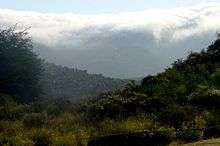Camanchaca
Camanchacas are marine stratocumulus cloud banks that form on the Chilean coast, by the Earth's driest desert, the Atacama Desert, and move inland. (In Peru, camanchaca is called garúa) On the side of the mountains where these cloud banks form, the camanchaca is a dense fog that does not produce rain.[1] The moisture that makes up the cloud measure between 1 and 40 microns across, too fine to form rain droplets.[2]

Fog collection
In 1985, scientists devised a fog collection system of polyolefin netting to capture the water droplets in the fog to produce running water for villages in these otherwise desert areas. The Camanchacas Project installed 50 large fog-collecting nets on a mountain ridge, which capture some 2% of the water in the fog.[2]
In 2005, another installation of panels of 3 square metres (32 sq ft) producing 5 litres (1.1 imp gal; 1.3 US gal) per square meter per day.[2]
References
- Vesilind, Priit J. (2003). "The Driest Place on Earth". National Geographic. Retrieved 12 September 2013.
- Lavars, Nick (August 25, 2015). "How Chile's fogcatchers are bringing water to the driest desert on Earth". www.gizmag.com. Retrieved 2015-08-25.